Investigating the effects of task repetition on fluency and accuracy in English oral performance of low level adult students: A case study at Vietnam air defence and air force academy
The major aims of this case study were to investigate the effects of task repetition on three adult
students’ accuracy and fluency in speaking English. Also, it sought to examine changes to the level
of anxiety when speaking, which is a secondary aim. Qualitative research method was applied,
with assistance of some quantitative analysis. The findings revealed that the participants generally
showed improvements in their accuracy, while fluency took slightly different ends. As regards the
level of anxiety, some minor decrease was observed as a result of repeating the task. Besides, all
the participants made modification of content in their second presentation, which opens a new
research domain for my future study.
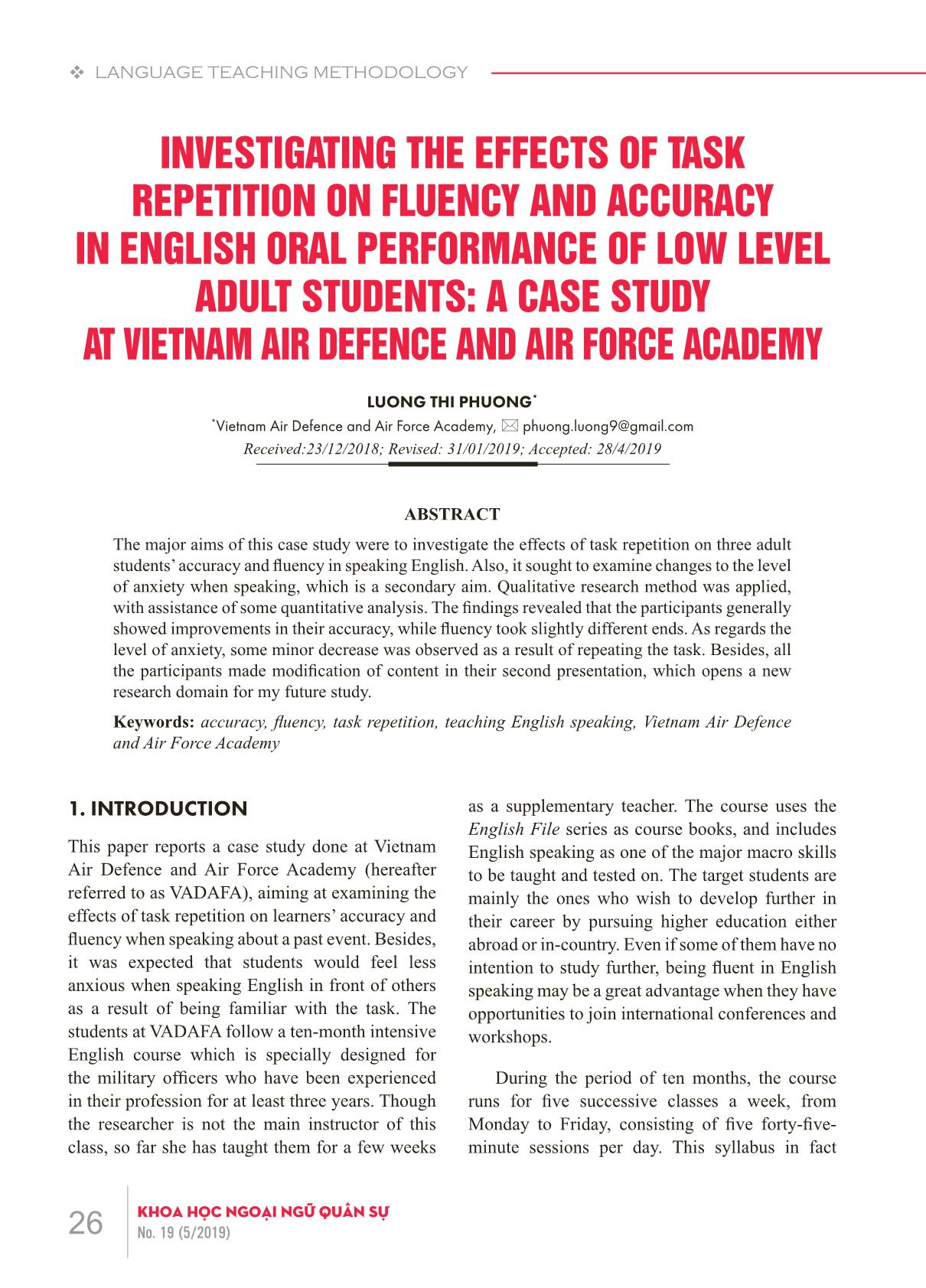
Trang 1
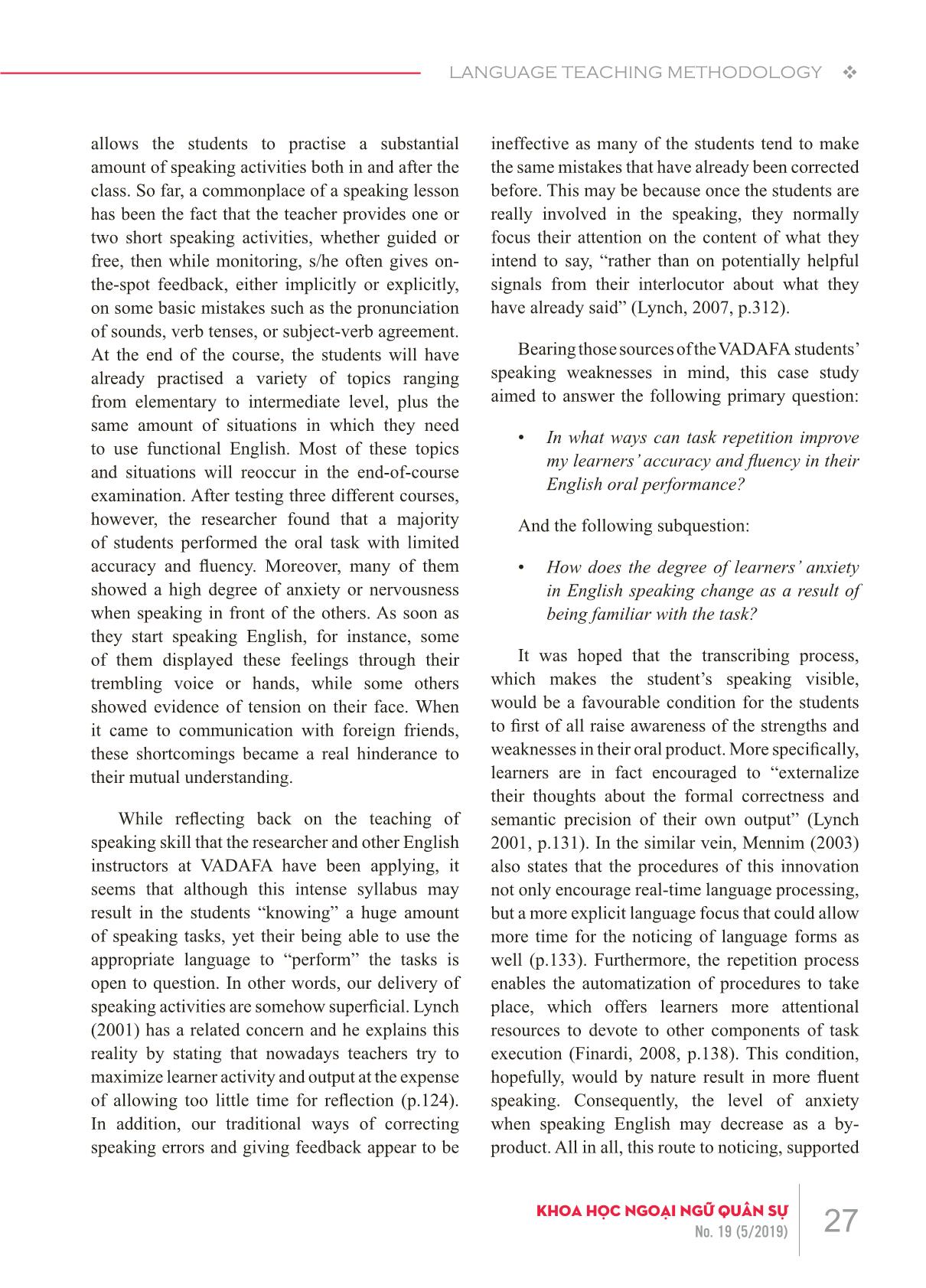
Trang 2
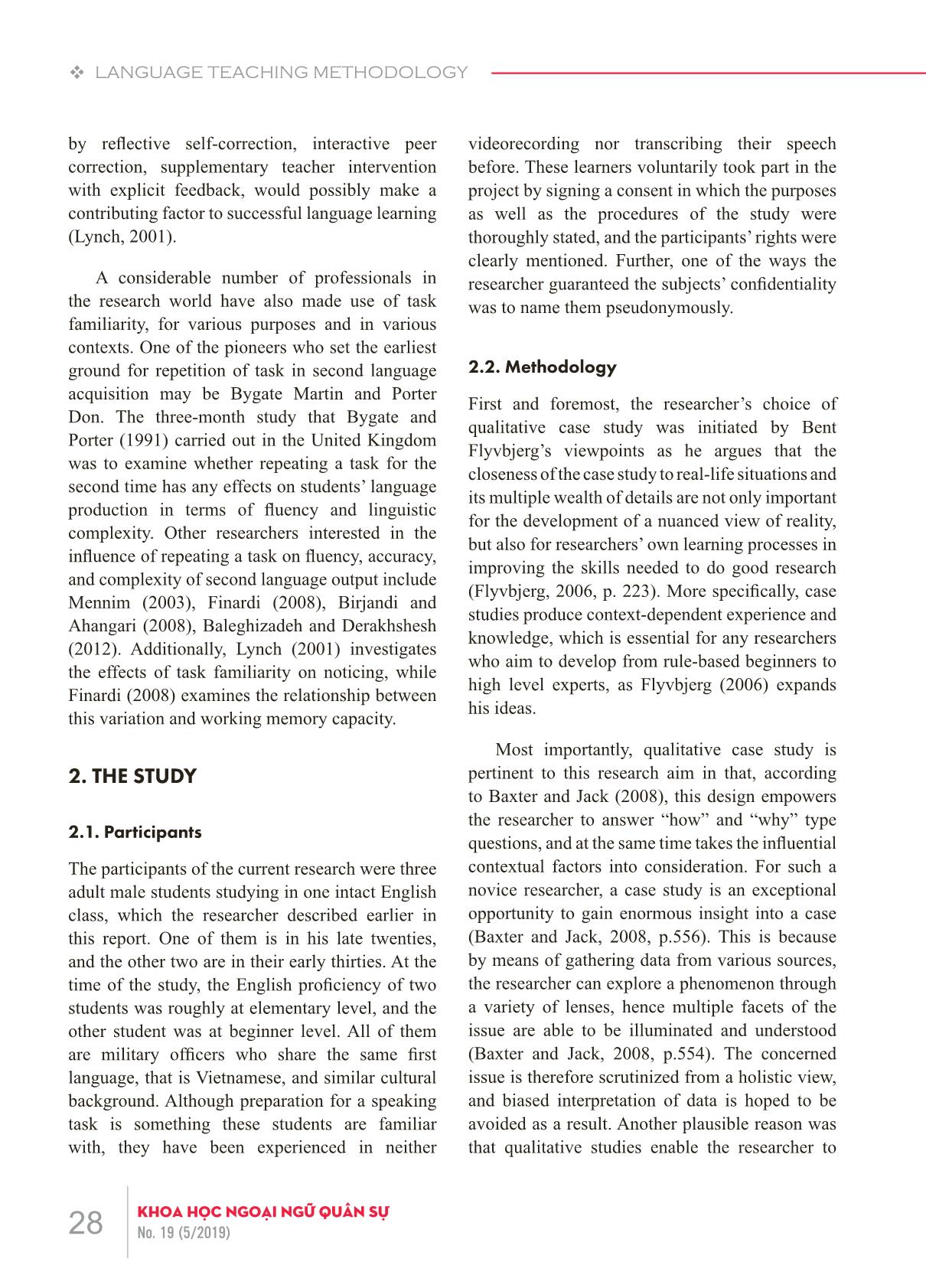
Trang 3
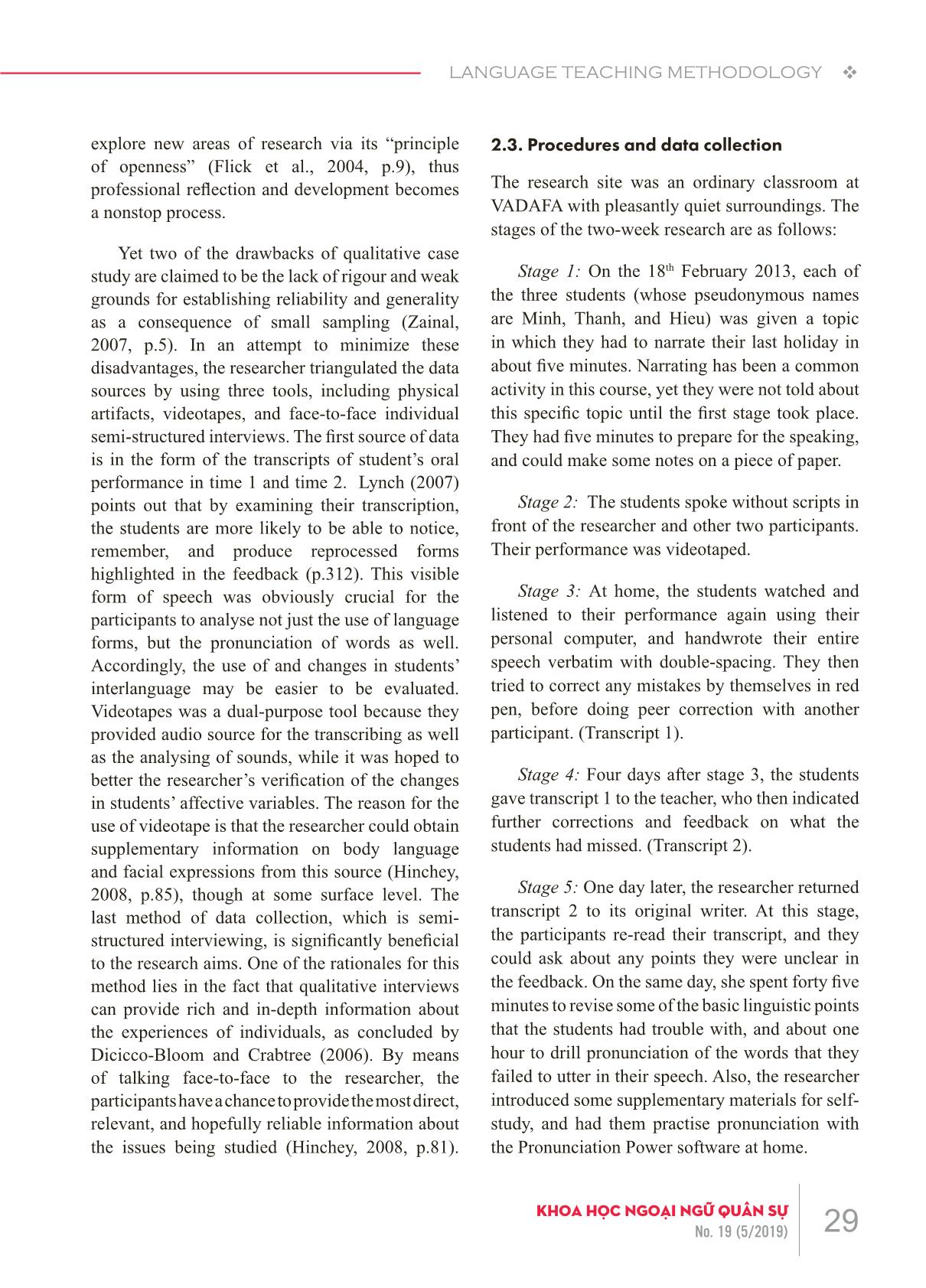
Trang 4
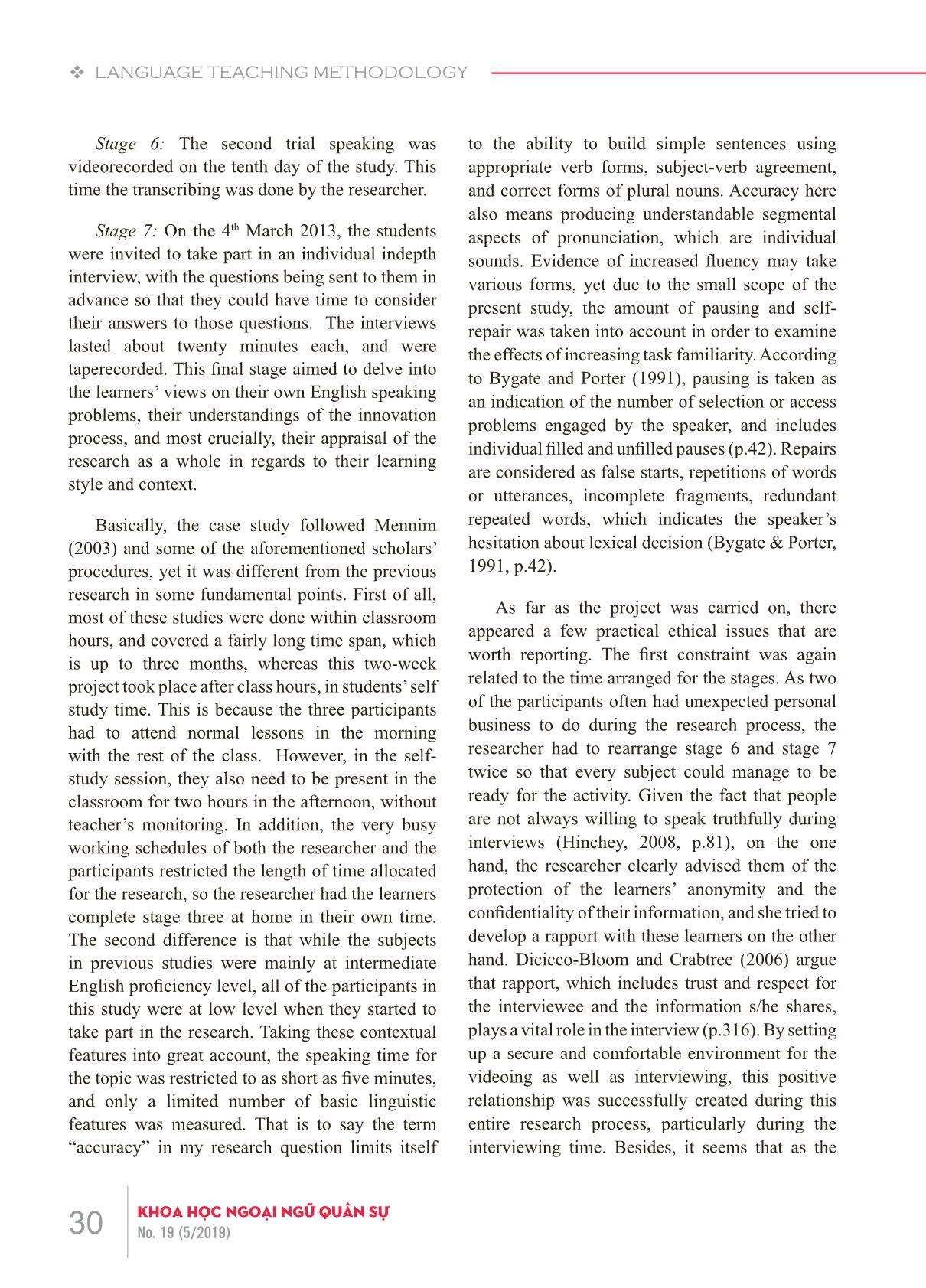
Trang 5
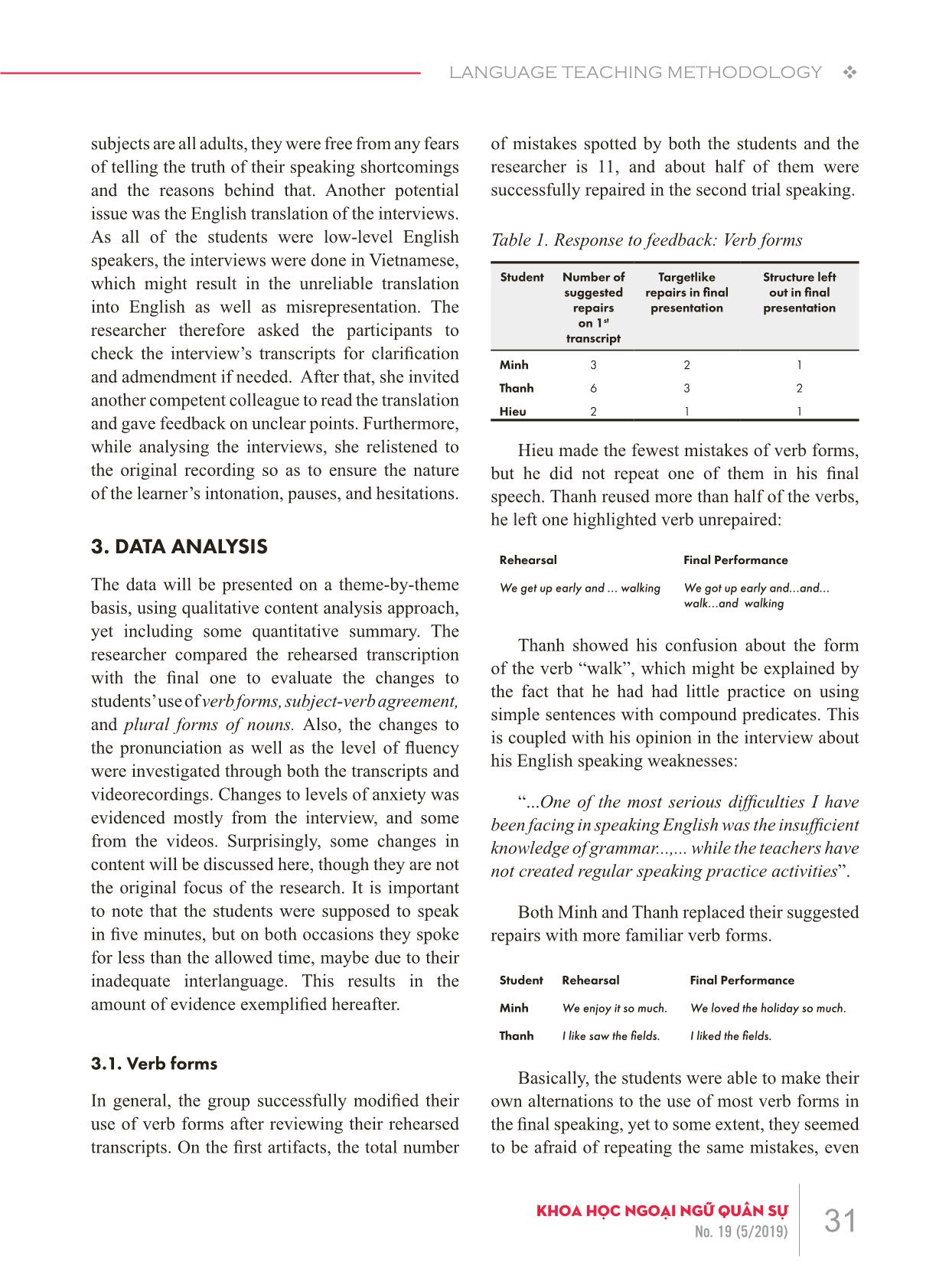
Trang 6
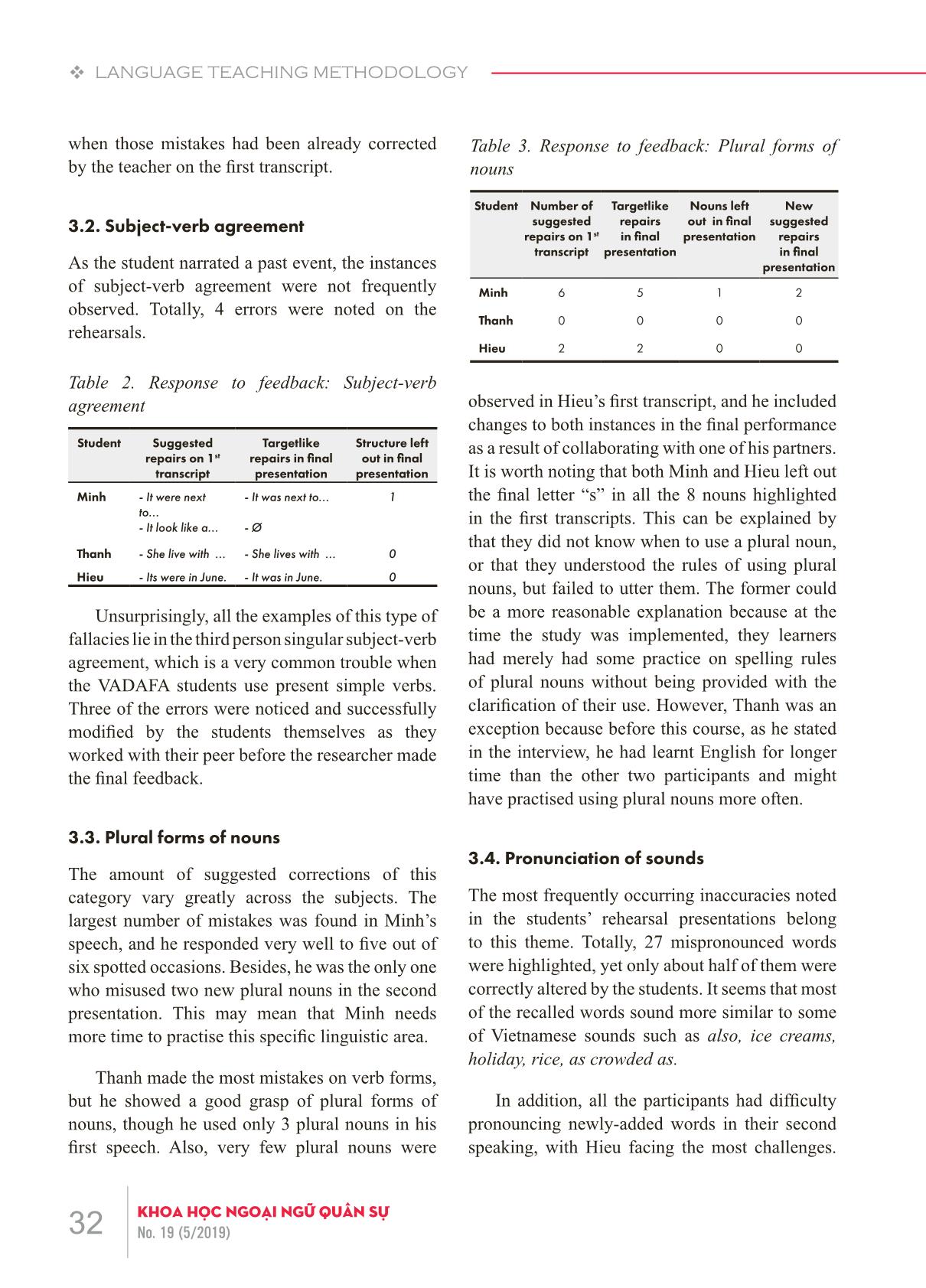
Trang 7
Tóm tắt nội dung tài liệu: Investigating the effects of task repetition on fluency and accuracy in English oral performance of low level adult students: A case study at Vietnam air defence and air force academy
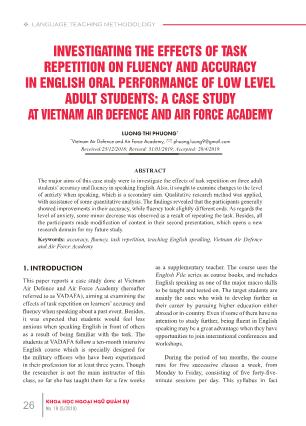
n, the students are more likely to be able to notice, remember, and produce reprocessed forms highlighted in the feedback (p.312). This visible form of speech was obviously crucial for the participants to analyse not just the use of language forms, but the pronunciation of words as well. Accordingly, the use of and changes in students’ interlanguage may be easier to be evaluated. Videotapes was a dual-purpose tool because they provided audio source for the transcribing as well as the analysing of sounds, while it was hoped to better the researcher’s verification of the changes in students’ affective variables. The reason for the use of videotape is that the researcher could obtain supplementary information on body language and facial expressions from this source (Hinchey, 2008, p.85), though at some surface level. The last method of data collection, which is semi- structured interviewing, is significantly beneficial to the research aims. One of the rationales for this method lies in the fact that qualitative interviews can provide rich and in-depth information about the experiences of individuals, as concluded by Dicicco-Bloom and Crabtree (2006). By means of talking face-to-face to the researcher, the participants have a chance to provide the most direct, relevant, and hopefully reliable information about the issues being studied (Hinchey, 2008, p.81). 2.3. Procedures and data collection The research site was an ordinary classroom at VADAFA with pleasantly quiet surroundings. The stages of the two-week research are as follows: Stage 1: On the 18th February 2013, each of the three students (whose pseudonymous names are Minh, Thanh, and Hieu) was given a topic in which they had to narrate their last holiday in about five minutes. Narrating has been a common activity in this course, yet they were not told about this specific topic until the first stage took place. They had five minutes to prepare for the speaking, and could make some notes on a piece of paper. Stage 2: The students spoke without scripts in front of the researcher and other two participants. Their performance was videotaped. Stage 3: At home, the students watched and listened to their performance again using their personal computer, and handwrote their entire speech verbatim with double-spacing. They then tried to correct any mistakes by themselves in red pen, before doing peer correction with another participant. (Transcript 1). Stage 4: Four days after stage 3, the students gave transcript 1 to the teacher, who then indicated further corrections and feedback on what the students had missed. (Transcript 2). Stage 5: One day later, the researcher returned transcript 2 to its original writer. At this stage, the participants re-read their transcript, and they could ask about any points they were unclear in the feedback. On the same day, she spent forty five minutes to revise some of the basic linguistic points that the students had trouble with, and about one hour to drill pronunciation of the words that they failed to utter in their speech. Also, the researcher introduced some supplementary materials for self- study, and had them practise pronunciation with the Pronunciation Power software at home. 30 KHOA HỌC NGOẠI NGỮ QUÂN SỰNo. 19 (5/2019) v LANGUAGE TEACHING METHODOLOGY Stage 6: The second trial speaking was videorecorded on the tenth day of the study. This time the transcribing was done by the researcher. Stage 7: On the 4th March 2013, the students were invited to take part in an individual indepth interview, with the questions being sent to them in advance so that they could have time to consider their answers to those questions. The interviews lasted about twenty minutes each, and were taperecorded. This final stage aimed to delve into the learners’ views on their own English speaking problems, their understandings of the innovation process, and most crucially, their appraisal of the research as a whole in regards to their learning style and context. Basically, the case study followed Mennim (2003) and some of the aforementioned scholars’ procedures, yet it was different from the previous research in some fundamental points. First of all, most of these studies were done within classroom hours, and covered a fairly long time span, which is up to three months, whereas this two-week project took place after class hours, in students’ self study time. This is because the three participants had to attend normal lessons in the morning with the rest of the class. However, in the self- study session, they also need to be present in the classroom for two hours in the afternoon, without teacher’s monitoring. In addition, the very busy working schedules of both the researcher and the participants restricted the length of time allocated for the research, so the researcher had the learners complete stage three at home in their own time. The second difference is that while the subjects in previous studies were mainly at intermediate English proficiency level, all of the participants in this study were at low level when they started to take part in the research. Taking these contextual features into great account, the speaking time for the topic was restricted to as short as five minutes, and only a limited number of basic linguistic features was measured. That is to say the term “accuracy” in my research question limits itself to the ability to build simple sentences using appropriate verb forms, subject-verb agreement, and correct forms of plural nouns. Accuracy here also means producing understandable segmental aspects of pronunciation, which are individual sounds. Evidence of increased fluency may take various forms, yet due to the small scope of the present study, the amount of pausing and self- repair was taken into account in order to examine the effects of increasing task familiarity. According to Bygate and Porter (1991), pausing is taken as an indication of the number of selection or access problems engaged by the speaker, and includes individual filled and unfilled pauses (p.42). Repairs are considered as false starts, repetitions of words or utterances, incomplete fragments, redundant repeated words, which indicates the speaker’s hesitation about lexical decision (Bygate & Porter, 1991, p.42). As far as the project was carried on, there appeared a few practical ethical issues that are worth reporting. The first constraint was again related to the time arranged for the stages. As two of the participants often had unexpected personal business to do during the research process, the researcher had to rearrange stage 6 and stage 7 twice so that every subject could manage to be ready for the activity. Given the fact that people are not always willing to speak truthfully during interviews (Hinchey, 2008, p.81), on the one hand, the researcher clearly advised them of the protection of the learners’ anonymity and the confidentiality of their information, and she tried to develop a rapport with these learners on the other hand. Dicicco-Bloom and Crabtree (2006) argue that rapport, which includes trust and respect for the interviewee and the information s/he shares, plays a vital role in the interview (p.316). By setting up a secure and comfortable environment for the videoing as well as interviewing, this positive relationship was successfully created during this entire research process, particularly during the interviewing time. Besides, it seems that as the 31KHOA HỌC NGOẠI NGỮ QUÂN SỰNo. 19 (5/2019) LANGUAGE TEACHING METHODOLOGY v subjects are all adults, they were free from any fears of telling the truth of their speaking shortcomings and the reasons behind that. Another potential issue was the English translation of the interviews. As all of the students were low-level English speakers, the interviews were done in Vietnamese, which might result in the unreliable translation into English as well as misrepresentation. The researcher therefore asked the participants to check the interview’s transcripts for clarification and admendment if needed. After that, she invited another competent colleague to read the translation and gave feedback on unclear points. Furthermore, while analysing the interviews, she relistened to the original recording so as to ensure the nature of the learner’s intonation, pauses, and hesitations. 3. DATA ANALYSIS The data will be presented on a theme-by-theme basis, using qualitative content analysis approach, yet including some quantitative summary. The researcher compared the rehearsed transcription with the final one to evaluate the changes to students’ use of verb forms, subject-verb agreement, and plural forms of nouns. Also, the changes to the pronunciation as well as the level of fluency were investigated through both the transcripts and videorecordings. Changes to levels of anxiety was evidenced mostly from the interview, and some from the videos. Surprisingly, some changes in content will be discussed here, though they are not the original focus of the research. It is important to note that the students were supposed to speak in five minutes, but on both occasions they spoke for less than the allowed time, maybe due to their inadequate interlanguage. This results in the amount of evidence exemplified hereafter. 3.1. Verb forms In general, the group successfully modified their use of verb forms after reviewing their rehearsed transcripts. On the first artifacts, the total number of mistakes spotted by both the students and the researcher is 11, and about half of them were successfully repaired in the second trial speaking. Table 1. Response to feedback: Verb forms Student Number of suggested repairs on 1st transcript Targetlike repairs in final presentation Structure left out in final presentation Minh 3 2 1 Thanh 6 3 2 Hieu 2 1 1 Hieu made the fewest mistakes of verb forms, but he did not repeat one of them in his final speech. Thanh reused more than half of the verbs, he left one highlighted verb unrepaired: Rehearsal Final Performance We get up early and ... walking We got up early and...and... walk...and walking Thanh showed his confusion about the form of the verb “walk”, which might be explained by the fact that he had had little practice on using simple sentences with compound predicates. This is coupled with his opinion in the interview about his English speaking weaknesses: “...One of the most serious difficulties I have been facing in speaking English was the insufficient knowledge of grammar...,... while the teachers have not created regular speaking practice activities”. Both Minh and Thanh replaced their suggested repairs with more familiar verb forms. Student Rehearsal Final Performance Minh We enjoy it so much. We loved the holiday so much. Thanh I like saw the fields. I liked the fields. Basically, the students were able to make their own alternations to the use of most verb forms in the final speaking, yet to some extent, they seemed to be afraid of repeating the same mistakes, even 32 KHOA HỌC NGOẠI NGỮ QUÂN SỰNo. 19 (5/2019) v LANGUAGE TEACHING METHODOLOGY when those mistakes had been already corrected by the teacher on the first transcript. 3.2. Subject-verb agreement As the student narrated a past event, the instances of subject-verb agreement were not frequently observed. Totally, 4 errors were noted on the rehearsals. Table 2. Response to feedback: Subject-verb agreement Student Suggested repairs on 1st transcript Targetlike repairs in final presentation Structure left out in final presentation Minh - It were next to... - It look like a... - It was next to... - Ø 1 Thanh - She live with ... - She lives with ... 0 Hieu - Its were in June. - It was in June. 0 Unsurprisingly, all the examples of this type of fallacies lie in the third person singular subject-verb agreement, which is a very common trouble when the VADAFA students use present simple verbs. Three of the errors were noticed and successfully modified by the students themselves as they worked with their peer before the researcher made the final feedback. 3.3. Plural forms of nouns The amount of suggested corrections of this category vary greatly across the subjects. The largest number of mistakes was found in Minh’s speech, and he responded very well to five out of six spotted occasions. Besides, he was the only one who misused two new plural nouns in the second presentation. This may mean that Minh needs more time to practise this specific linguistic area. Thanh made the most mistakes on verb forms, but he showed a good grasp of plural forms of nouns, though he used only 3 plural nouns in his first speech. Also, very few plural nouns were observed in Hieu’s first transcript, and he included changes to both instances in the final performance as a result of collaborating with one of his partners. It is worth noting that both Minh and Hieu left out the final letter “s” in all the 8 nouns highlighted in the first transcripts. This can be explained by that they did not know when to use a plural noun, or that they understood the rules of using plural nouns, but failed to utter them. The former could be a more reasonable explanation because at the time the study was implemented, they learners had merely had some practice on spelling rules of plural nouns without being provided with the clarification of their use. However, Thanh was an exception because before this course, as he stated in the interview, he had learnt English for longer time than the other two participants and might have practised using plural nouns more often. 3.4. Pronunciation of sounds The most frequently occurring inaccuracies noted in the students’ rehearsal presentations belong to this theme. Totally, 27 mispronounced words were highlighted, yet only about half of them were correctly altered by the students. It seems that most of the recalled words sound more similar to some of Vietnamese sounds such as also, ice creams, holiday, rice, as crowded as. In addition, all the participants had difficulty pronouncing newly-added words in their second speaking, with Hieu facing the most challenges. Table 3. Response to feedback: Plural forms of nouns Student Number of suggested repairs on 1st transcript Targetlike repairs in final presentation Nouns left out in final presentation New suggested repairs in final presentation Minh 6 5 1 2 Thanh 0 0 0 0 Hieu 2 2 0 0
File đính kèm:
 investigating_the_effects_of_task_repetition_on_fluency_and.pdf
investigating_the_effects_of_task_repetition_on_fluency_and.pdf

